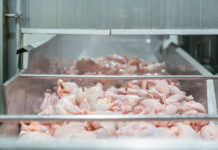
As a proof of the company’s long-term dedication of being involved in layer genetics, a new facility has been opened on the 30th October 2018 for their pure line program. The breeding company has now three pedigree farms and existing test facilities in Uraiújfalu, Hungary.
The construction of the new research unit financed partly by the breeding company as well as by EU funds. Research and development work here focusing mainly on new international market requirements, such as cream-colored egg production, increased tolerance of high environmental temperature in changing climatic conditions, in layers and medium and fast-growing hybrids. In addition, new precision feeding technologies are being developed between 2017-2020 supported by the Higher Education and Industrial Cooperation Centre – Research Infrastructure development, under the name of “Crop production and animal husbandry technologies adapted for climatic changes, sustainable agriculture and quality food production under intensive production environment“. The huge project is led by Kaposvár University, that has received 12,7 million euros grant along with Bábolna TETRA and Dalmand Co. in 2016.
Zoltán Budai, owner and managing director of TETRA, said, with the facility that is now opened, the company is owning 50.000 elite hens all together in individual cages in two locations where they can keep on track the development of single and egg production. In addition, 28.000 layers are kept in individual and group cages for test purpose. These animals are the genetic base of the company. The quantity and quality parameters of the hens as well as the behaviour and resistance ability are investigated under various management conditions. Data is processed by a state-of-the-art computer technology with speed and efficiency.
The company opened its new eco-hatchery in Uraiújfalu in 2014, which is also located in the western part of Hungary. All pure line and layer breeder hatching eggs are transported here, where qualified and dedicated staff, and hatching machines of the latest technology, are ensuring day-old chicks of the highest quality The fact that the company already had this facility, encouraged them to set up its new facility in the same geographical area. TETRA layers hatchery has the capacity of 32 million eggs per year and more than 12 million day-old pullets.

The new pure line operation consists of one production barn. It became operational in November 2018 and now houses 20.440 pedigree hens and 1.440 males in individual cages. The purpose of individual cages are well known for all, as gathering data on the most economically important traits of egg production, egg size and quality, can only be done on an individual bird basis. Each bird has a wing band, which is combined with an individual barcode on the front of the cage that is scanned by an employee using a handheld device each time a measurement is taken that is unique to a particular bird. The barcode data is sent to a computer on the farm. The same device is used for collecting body and egg weight data. Eggs produced are also given the number of the cage so that the geneticists know, which bird laid which egg, a crucial step for measuring egg quality traits such as shell strength and colour of the eggs. The possibility to have birds in single cages for research purpose is still allowed in Hungary, but it requires special permit from the relevant authorities. Even if birds are kept in individual cages, welfare must always be a priority.
The grand opening of the pure line facility took place on month after the TETRA Seminar, held between 4-6 October 2018 in Hajdúszoboszló in the eastern part of Hungary. TETRA representatives and partners from almost every eastern European country attended on the event, where various lectures had been heard in Russian language. Guests were treated with great respect and participated on social and leisure programs after the presentations on the first day. Attendees were also provided with information on breeding and marketing vision of the company and a general overview of how TETRA sales team operates in other parts of the world.
The target of Bábolna TETRA layer breeding has not changed much throughout the last decade; finding balance between welfare and economical production and increasing its share in the global market by predicting future trends of the sector. New challenges need to be approached with effective R&D in cooperation with scientific institutes. Among the most important traits remains production, egg quality and viability. The increased genetic potential of the birds of newly applied selection strategies must always be shown in the field.
















